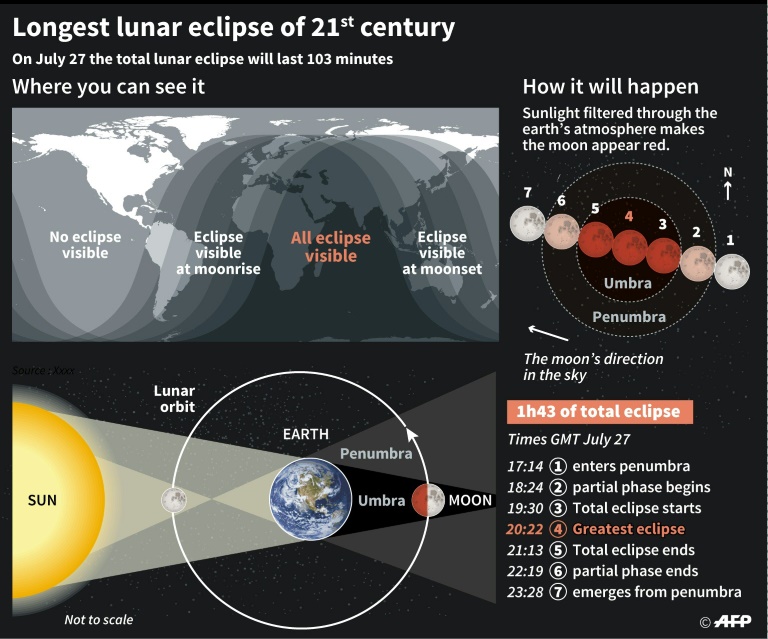The longest "blood moon" eclipse this century dazzled skygazers across the globe Friday, coinciding with Mars' closest approach in 15 years in a thrilling celestial spectacle.
As Earth's constant companion slowly sailed across the skies, crowds gathered around the world to catch a glimpse of the rare phenomenon.
Mars appeared unusually large and bright, a mere 57.7 million kilometres from Earth on its elliptical orbit around the sun.
A total lunar eclipse happens when Earth takes position in a straight line between the moon and sun, blotting out the direct sunlight that normally makes our satellite glow whitish-yellow.

The moon travels to a similar position every month, but the tilt of its orbit means it normally passes above or below the Earth's shadow -- so most months we have a full moon without an eclipse.
When the three celestial bodies are perfectly lined up, however, the Earth's atmosphere scatters blue light from the sun while refracting or bending red light onto the moon, usually giving it a rosy blush.
This is what gives the phenomenon the name "blood moon", though Mark Bailey of the Armagh Observatory in Northern Ireland said the colour can vary greatly.
It depends partly on "how cloudy or transparent those parts of the Earth's atmosphere are which enable sunlight to reach the moon", he told AFP.
"During a very dark eclipse the moon may be almost invisible."
The long duration of this eclipse was partly because the moon made a near-central passage through Earth's umbra -- the darkest, most central part of the shadow.
"For those alive today, it's a unique event," said Sven Melchert, head of a local society of astronomy enthusiasts in Heppenheim, western Germany, cited by the DPA news agency.
The moon was also at the farthest point on its orbit from Earth, making its movement across the sky slower from our perspective, thus spending longer in the dark.
NASA, meanwhile, called out social media hoaxers claiming that Mars would appear as big as the moon during the eclipse.
"If that were true, we'd be in big trouble given the gravitational pulls on Earth, Mars, and our moon!" the NASA website stated.
Mars instead appeared as a very bright star.
"In the middle of a lunar eclipse it can look as if a red planet has taken up residence near the Earth -- they are both eerie and beautiful," said Robert Massey of the Royal Astronomical Society in London.


